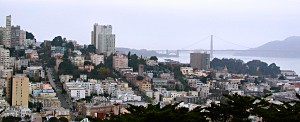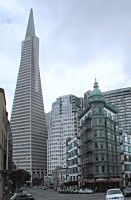October 24 - 29, 2001
... is something we have here, too, in San Francisco. Shortly after our recent visit there, I joined the working class myself.
| Workers' Movement Museum October 24 - 29, 2001 ... is something we have here, too, in San Francisco. Shortly after our recent visit there, I joined the working class myself. |
 |
||
| San Francisco from Coit Tower - the zigzaggy street on the left is Lombard Street, and Golden Gate Bridge on the right |
"... and don't forget the Workers' Movement Museum!" we remind carefully every visiting party before they leave for San Francisco. It is interesting to watch people's reactions - they usually tighten up and you can watch on their faces that behind an uncertain look they feverishly search their minds whether we really mean it (which would lead to a polite withdrawal), or whether it may be a joke of some sort (which should lead to a polite laughter). My mother got outright sick right at a railroad station, going to San Francisco. First, we naturally thought of food poisoning or general exhaustion, but backtracking the events, I think it might have been my careless note about the Museum. Anyway, mom did not get to San Francisco on that day, we put it off and made it a family outing.
Meanwhile, mother became ill to the level that before leaving to Monterey on Friday, we visited Urgent Care. An ordeal with telephoning back and forth between the clinic and insurance agency (in Czech Republic), and Sid, took at least three hours and culminated in a conclusion that we were to pay for everything anyway, and will have the privilege to "submit the bills for reimbursement" at a much later time. My skepticism receded a bit after the insurance company, Generali, bothered to call in the afternoon and collect all necessary information. Our all-girl trip to Monterey, belated and shortened, could take place.
 |
||
| We're driving down Lombard Street, which ends on the other hill, under Coit Tower. Most of Treasure Island can be seen in the background. |
The insurance company called again. At five thirty in the morning. Being asked if they realized what time it was in California, they said it was nine thirty and what about it. The person was unmoved by the fact that daylight saving time just ended (even as it did in CZ) and that he was not calling New York, but another edge of America, though they had collected all information about us previously. He could eventually be moved to be as extremely tolerant of our aberrant ways as to call later.
A third call rang at seven thirty (still on the same Sunday morning) with the explanation that the time it was placed was based on average American time (whatever that may be). This journal is a decent periodical and I can't possibly come up with any publishable comment to this behavior.
Well the deed was done -- all were awake quite thoroughly now, there was no point in trying to put off our planned activity and fall asleep again. After all -- laziness does not befit for visitors of the Workers' Movement Museum -- one should not wallow on decadent imperialist pillows, but rise up, and with a merry song on the lips stride forward to glorious victories of tomorrow.
 |
||
| Here we found ourselves in a Workers' Movement Museum. A painted worker right of the window is reaching into the bookcase for Das Kapital by Karl Marx. |
We did not accomplish much of the striding, for it is quite a few miles away. Trusting our experience with weekend de-population of San Francisco streets, we took our wagon. Not much luck there - it was overcast and inhabitants of the City sat at their homes, probably watching TV -- and their cars were parked thickly all over the most improbable places. Hippo was fuming and our clutch smelled bad (those steep up and downhill streets that criminals and heroes fly through when chasing each other in action movies, are very real in San Francisco). At least we drove through the zigzag section of Lombard Street - the slope is so steep that they made it switch back to prevent cars from tumbling over. Finally, we found a parking spot. There was about a two-yard stripe of curb between two garage driveways - we simply hoped that none of the owners boast a road schooner, and that they would not nibble at our wagon -- and ran up steps to Coit Tower.
Coit Tower was built in 1933 in memory of Lillie Hitchcock Coit, who bequeathed $118,000 (a third of her estate) to San Francisco for "The purpose of adding beauty to the City which I have always loved." She came here as a seven year old child with her parents from Kentucky in 1851. She was saved by firemen during a large city fire and became their mascot, who rarely missed a blaze.
 |
||
| A most famous skyscraper of SF - TransAmerica Building |
As an adult, she led a flamboyant life - married Howard Coit of Telegraph Hill against her family's wishes, smoked cigars and often gambled in North Beach saloons, dressed in man's clothes. An envious relative tried to kill her, but missed and killed Lillie's friend who tried to protect her. Lillie fled to Paris. There she became a favorite of the Court of Napoleon III, and returned to San Francisco in 1923; she died here in 1929 at age 88.
Lillie would certainly be proud - Coit Tower is located on a beautiful place
and from its gallery, one can overlook the whole City and much of the Bay.
One side shows the downtown with skyscrapers, another offers a view to
Lombard Street, Golden Gate, the fort of Alcatraz, SF piers, Bay Bridge,
Treasure Island...
For some reason, the ground floor is decorated with socialist-realism murals.
Workers in factories, farmers in fields, working intellectuals in their offices.
Pickpockets, robbers, policemen, maids, rich ladies, and omnipresent proletariat;
all slightly larger than life. Locals may not find it strange, only those like us, who
had been exposed to the Big Red Brother, would notice details like "worker
at a library" reaching for Marx's Das Kapital. Hence our nickname
for Coit Tower: Workers' Movement Museum.
One's appetite comes to notice when seeing all those poor, hungry, exploited masses. Sid promised us another attraction, a lunch in Chinatown. The place looks strange, smells strange and quite intensely; signs over the stores are Chinese, and there is a human congestion everywhere. Mothers with uncountable numbers of children, husbands waiting patiently at a curb, clutching many plastic bags with their wives' shopping items, while their wives fill more plastic bags with mostly food that "round eyes" like us don't dare to imagine where it comes from; Chinese ancestors -- perhaps grand-grandfathers, who look mummified although they keep breathing and walking; windows with laundry hanging out; thousands of food stands and restaurants. Without hesitation, Sid headed for most crowded eatery, and after half an hour we were regretting our decision to order three meals for three people. Half of the amount would perfectly suffice, still allowing for Hippo's appetite. So we enjoyed it, though Chinese food here bears no relationship with anything named so somewhere in Europe. Amidst all the rush and smell, Chinese custom of leaving kitchens open or behind big glazed panes, to allow full customer scrutiny of the food and preparation process, has a reassuring effect. Formica tables in the end lose some of its disgusting appearance, when you see stainless steel kitchen equipment and cooks wearing hats and clean coats.
Our nerves were well wrapped in lard after this break, ready for the next attraction, that is, a ride on a historic cable car. You would not believe how many people fit in and on this tiny thing - an old man tugged at large levers on a front platform and rang a bell, surrounded by two hard, wooden benches with passengers from each side. I thought that a seat there would guarantee a good view, but I was wrong -- I did not notice large vertical handles, or more precisely, I had no idea that within a minute whole clusters of additional passengers would grab them and hang on for their lives. It's funny when two such packed cable cars pass in opposite directions -- outer hanging passengers must suddenly press in, among sitting ones, to avoid collision with their counterparts. Sid with my mom were not quick enough and had to accept seats in a rear and enclosed portion of the car. An agile conductor was pushing all remaining riders from the front platform into the cabin: "all turn facing the windows, backs to the middle of the car, one next to another, you can all fit in!" And that was not the end of it. In the middle of our ride, after a screeching turn the car drifted into a slope and stopped. The old man tugged at a break handle, grabbed his worn out lunchbox, and stepped out. Our conductor shouted that their shift was over and next one would be here shortly; then she, too, stepped out. Everybody in the car sat amidst a sudden uneasy silence, watching each other. Fortunately, a new crew really came soon.
They were better than the old team -- two big black guys did not seem to take their roles so gravely seriously like the old white man before, and joked with passengers all the time. The driver took it so far that in the very last, steep downhill, where everybody could see rails disappearing into a pier ending in the Bay, he tapped the nearest passenger on his shoulder and asked him to "take over for a moment", and stepped out! It was really just a joke, and he jumped right back and was braking noisily.
The cable car's line terminates right across from "The Buena
Vista Cafe" - and there were three vacant stools at the bar. Soon, Irish coffee
was warming our stomachs. I think we really deserved this divine drink (although
I wonder why they call it coffee, while it consists mostly of whisky and cream).
On Monday I took mom to the SFO airport. They were still recommending to arrive at least three hours prior to departure, and so I stayed there with her for an hour and we had a coffee together. I came back home depressed -- it started raining outside, and it became foggy and altogether ugly.
Our voicemail machine contained the greatest surprise of the year
-- the only company that ever invited me for an interview here in California, was offering
me a job, beginning first of November. I am simply amazing - I found a job exactly right
when my mom left, and started working on a day when news brought official reports about
highest unemployment rate in last twenty years. Don't you think I'm way
cool???? 
| Copyright © 2001-2005 by Carol & Sid Paral. All rights reserved. |